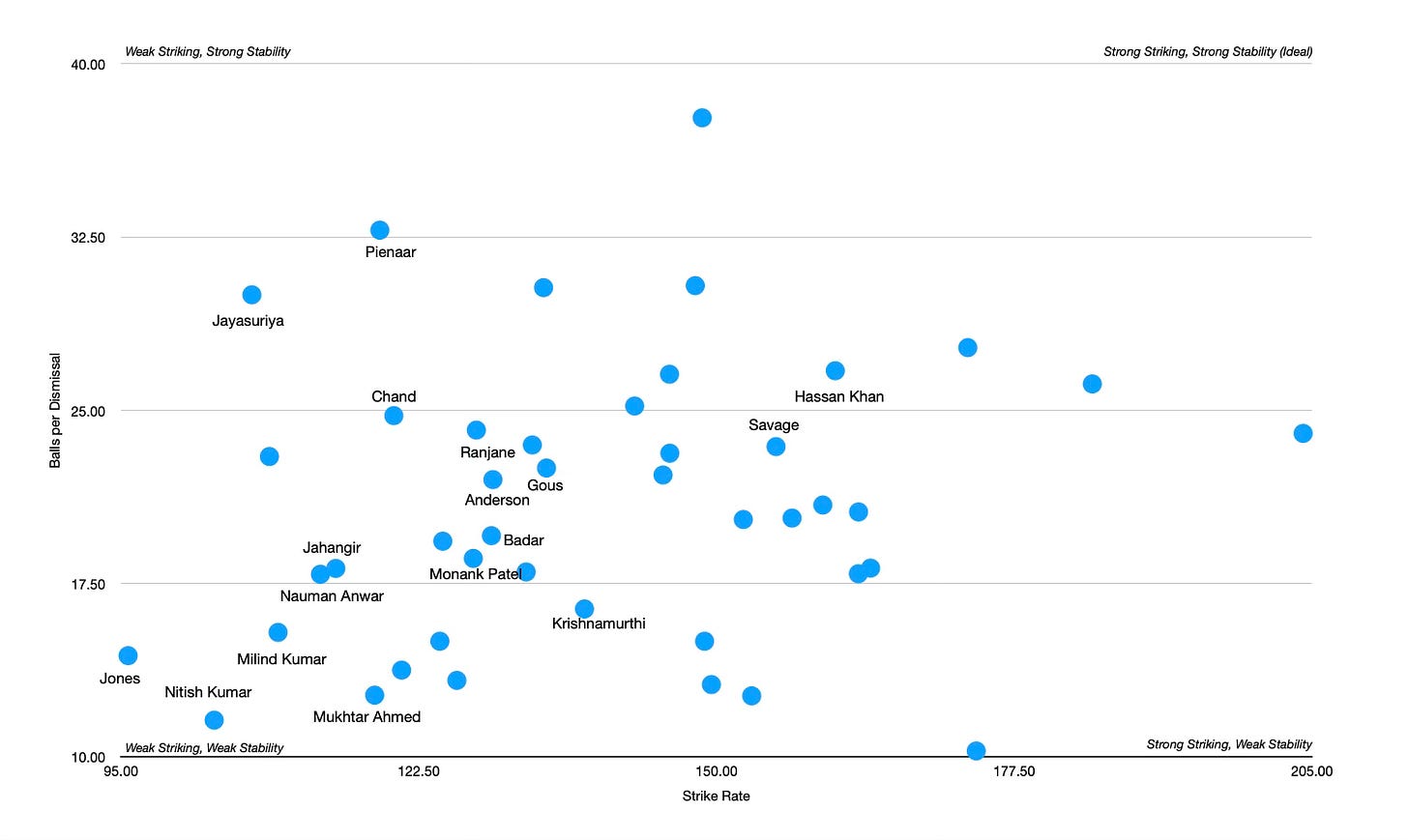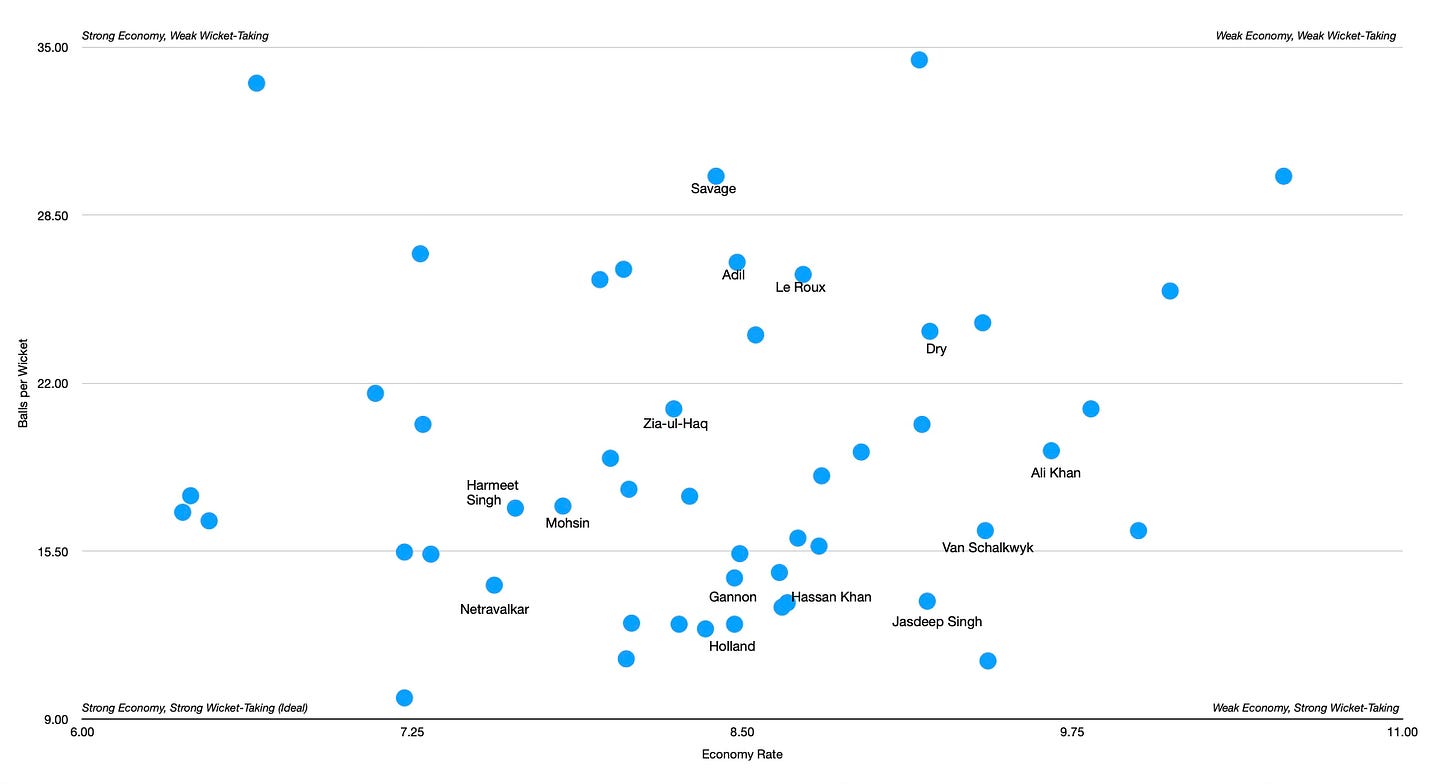Optimizing MLC Squad Building & Strategy
We are now almost halfway through the third season of Major League Cricket, and it still seems evident that many teams are still lacking in their roster construction, team construction and in-match strategy.
This is the case both for overseas players and domestic players, but for this post I want to chat further about how to optimize the impact from domestic players, which is a critical facet of MLC squad building.
League dynamics, as with every league, drives the importance of this. Each MLC team has to play five domestic players in their starting XI, so will focus on a 5 domestic/6 overseas balance. Across the six teams, this means that 30 domestic players need to feature regularly, which will rise to 40 when the league expands to eight teams, which appears likely in the near future - diluting the quality of the domestic player pool even further.
In tournaments like the IPL and The Hundred, the ability gap between overseas players and domestic players is much smaller than that for leagues which are based in associate nations, such as the MLC (America) and ILT20 (UAE). Not only this, but the gap between the best and worst overseas players in the MLC is smaller than the gap between the best and worst domestic players.
The charts below (correct before match played on 23/6/25) illustrate this:-
MLC Batters 2023-2025, 100+ balls faced among currently active players
We can see here that most of the domestic players are grouped towards the least ideal bottom-left corner of the chart (weak striking, weak stability), showing the dilution in quality among domestic players in the MLC. On the flip side, Hassan Khan, Calvin Savage, Sanjay Krishnamurthi and Andries Gous look like the best domestic batters, frequently able to compete against overseas batters.
MLC Bowlers 2023-2025, 100+ balls bowled among currently active players
Harmeet Singh, Mohammad Mohsin and Saurabh Netravalkar have been the best performing domestic bowlers, with the likes of Cameron Gannon, Hassan Khan and Ian Holland also being strong contributors. Netravalkar, on a $40k retention, looks markedly undervalued given seven players were retained on $75k.
Given his batting and bowling involvement, is there a case for Hassan Khan to be the most valuable domestic player in the MLC?
Considering all this, and the large ability difference between the best and worst domestic players, the requirement to play five domestic players should be the first consideration when constructing a squad and team combinations ahead of the tournament. There might also be an argument to say that Hassan Khan should be the best paid player in the MLC, but this is far from the case currently.
As with other leagues such as the IPL (less so for The Hundred), there is a massive discrepancy between the best paid and worst paid players in the MLC. It’s not unheard of for players to be paid in excess of 100x the salary of their team-mates in these leagues, with some overseas players in the MLC being paid more than double the rate of the highest paid domestic players.
This points to a draft process which prioritises big overseas names, perhaps in an attempt to try and sell tickets (despite it being evident that there are only about five non-India players in the world who can have a strong impact in this area), although I have my doubts whether this would change much with a free market for player trading.
Even with these constraints about the player recruitment market for domestic players, some teams have managed to deal with the requirements better than others. Washington Freedom, for example, have managed to dramatically reduce the match involvement percentage (balls batted + balls bowled) from domestic players this year.
Conversely, MI New York and LA Knight Riders have not grasped the benefits of this strategy, often having greater than 45.45% domestic player match involvement (this is the key benchmark percentage for this metric because 5/11 players must be domestic, and would assume equal match involvement between domestic and overseas players).
In an attempt to find the ideal team structure for MLC teams, I performed a deep dive into in-depth data across the three seasons so far (includes matches played on 23/6/25).
Batting Involvement for Domestic Players
Winning teams had 33.71 balls on average batted by domestic players, with 2.11 domestic players on average featuring in their top six.
Losing teams had 41.73 balls on average batted by domestic players, with 2.36 domestic players on average featuring in their top six.
So, we can see already that minimizing batting involvement from domestic players makes sense (unless they can hit at a strong level, such as Hassan Khan, Andries Gous and Monank Patel). Washington Freedom have nailed this strategy, often having just one domestic player in their top six with that being Gous, who can access boundaries well.
Bowling Involvement for Domestic Players
Winning teams had 38.54% of their balls bowled on average by domestic players.
Losing teams had 38.02% of their balls bowled on average by domestic players.
It looks like 38% ish is the benchmark for this (45 balls per 120 ball bowling innings), with there being little difference between winning teams and losing teams. However, it’s interesting to note that winning teams bowled their domestic players very slightly more than losing teams, illustrating the benefits again of that 2 batter/3 bowler (or even 1/4) split.
A key determinant of bowling success for winning teams was the quality of domestic bowlers. In winning teams, domestic bowlers had an economy rate of 7.70 runs per over, while this rose dramatically to 9.35 runs per over conceded by domestic bowlers in losing teams.
Match Involvement for Domestic Players
Winning teams had 36.17% average match involvement from their five domestic players, and therefore 63.83% via their six overseas players. However, losing teams had 39.91% average match involvement from their five domestic players, and therefore 60.09% via their six overseas players.
Essentially, winning teams had an average of around 4.5 balls greater match involvement from their overseas players than losing teams, reinforcing again the positive expectation strategy of Washington Freedom, who look to have clearly adopted this identity.
Earlier I mentioned the key 45.45% benchmark for domestic player match involvement, which treats all 11 players in the team as equal regardless of their status as a domestic or overseas player.
Winning teams had 11 instances of domestic players having 45.45% match involvement, whereas losing teams had 15 instances, and quite bizarrely, this occurrence has been increasing this season - teams just haven’t learned anything over the three seasons so far.
Another way of looking at it - Winning teams had 10 instances of domestic players having 100+ ball match involvement out of a maximum of 240, while losing teams had 18 instances of this.
How should this information determine recruitment & in-match strategy for teams?
What would I do if I was running an MLC team? All this data points to one thing as a key strategy - minimise match involvement from those domestic players who are below average standard. A non-bowling or one over from a domestic number seven or eight has been a strategy successfully adopted by some teams.
Recruiting overseas batters who can bowl at least competent match-up spin (e.g. Michael Bracewell, Cooper Connolly, Donovan Ferreira, Glenn Maxwell, Glenn Phillips, Rachin Ravindra, Matt Short) helps greatly with creating flexibility with bowling distribution.
Likewise, overseas frontline bowlers who can hit (Gerald Coetzee, Matthew Forde, Jason Holder, Sunil Narine, Romario Shepherd) are also ultra-valuable types of players to achieve high match involvement for overseas players.
This then leads to prioritizing recruitment of the best domestic players, which is still an inefficient market when considering the current market prices of some (e.g. Netravalkar was retained at $40k, when he could have picked up $75k).
However, because of the capped dynamic for domestic recruitment (they can’t be signed outside the draft, which has fixed salary caps), teams can’t pay premium prices to sign the best domestic talent - but by whatever means possible, MLC teams must maximise their recruitment of the best domestic players.
Given those spending restrictions in the domestic market, a smart team would spend as much as is necessary on scouting and upskilling domestic players. Finding gems who qualify as domestic players from markets like India, South Africa and Pakistan could be a great way to improve the quality of domestic players in the market. Year-round coaching for domestic players to improve their skills would also be a potential investment for teams looking to maximise positive expected value.
Finally, strategically, during the tournament, I would recommend preparation work with batters in the team to profile weaker domestic bowlers who they can target, and strategically when considering over distribution, use 5th/6th bowlers against the domestic batters whose hitting is constrained (basically, you want these opposition batters to stay in and have high match involvement).
Anyone interested in discussing how I can help their organisation with strategic management, data-driven analysis and long-term planning can get in touch at sportsanalyticsadvantage@gmail.com.


